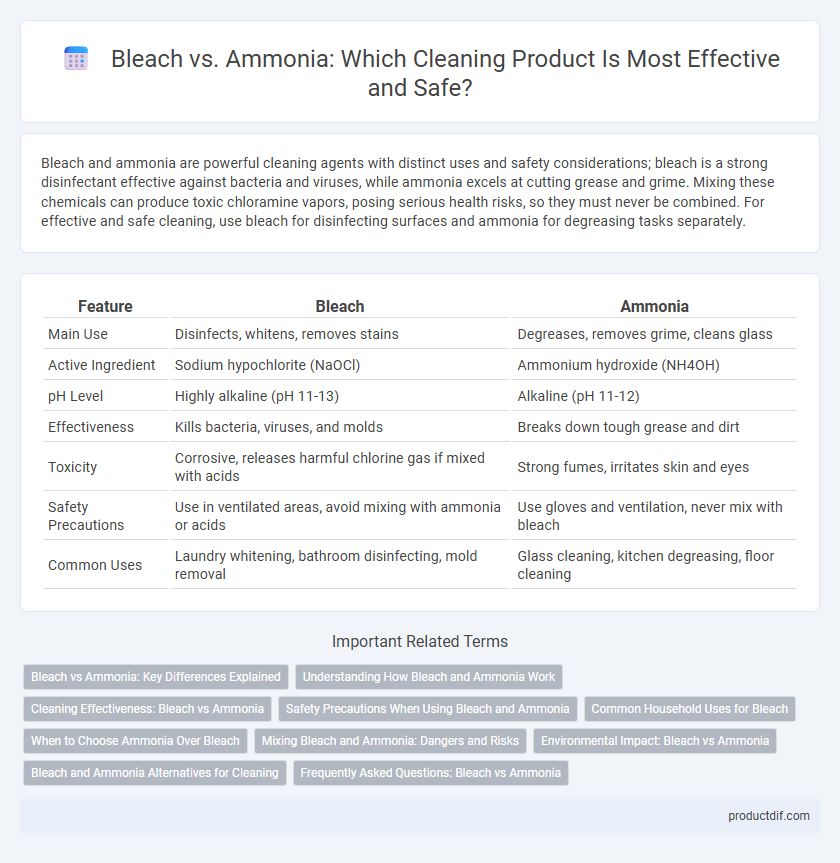Bleach and ammonia are powerful cleaning agents with distinct uses and safety considerations; bleach is a strong disinfectant effective against bacteria and viruses, while ammonia excels at cutting grease and grime. Mixing these chemicals can produce toxic chloramine vapors, posing serious health risks, so they must never be combined. For effective and safe cleaning, use bleach for disinfecting surfaces and ammonia for degreasing tasks separately.
Table of Comparison
| Feature | Bleach | Ammonia |
|---|---|---|
| Main Use | Disinfects, whitens, removes stains | Degreases, removes grime, cleans glass |
| Active Ingredient | Sodium hypochlorite (NaOCl) | Ammonium hydroxide (NH4OH) |
| pH Level | Highly alkaline (pH 11-13) | Alkaline (pH 11-12) |
| Effectiveness | Kills bacteria, viruses, and molds | Breaks down tough grease and dirt |
| Toxicity | Corrosive, releases harmful chlorine gas if mixed with acids | Strong fumes, irritates skin and eyes |
| Safety Precautions | Use in ventilated areas, avoid mixing with ammonia or acids | Use gloves and ventilation, never mix with bleach |
| Common Uses | Laundry whitening, bathroom disinfecting, mold removal | Glass cleaning, kitchen degreasing, floor cleaning |
Bleach vs Ammonia: Key Differences Explained
Bleach and ammonia are common cleaning agents with distinct chemical properties and uses; bleach contains sodium hypochlorite, making it a powerful disinfectant and stain remover, while ammonia is an alkaline solution effective at cutting grease and grime. Mixing bleach and ammonia produces toxic chloramine vapors, which can cause respiratory damage, highlighting the importance of using these substances separately. Understanding their specific applications ensures safe and effective cleaning in household and industrial environments.
Understanding How Bleach and Ammonia Work
Bleach, a powerful oxidizing agent, works by breaking down and destroying organic stains, bacteria, and viruses through the release of chlorine. Ammonia, a strong alkaline compound, cleans by lifting grease, grime, and dirt through its ability to dissolve organic matter and break down proteins. Mixing bleach and ammonia releases toxic chloramine vapors, making it crucial to use these products separately for effective and safe cleaning.
Cleaning Effectiveness: Bleach vs Ammonia
Bleach is highly effective at killing bacteria, viruses, and mold, making it ideal for disinfecting surfaces and whitening fabrics. Ammonia excels at cutting through grease and grime, especially on glass and hard surfaces, providing a streak-free shine. While bleach is a powerful sanitizer, ammonia is preferred for general cleaning tasks that require strong degreasing without the harsh chemical odor of bleach.
Safety Precautions When Using Bleach and Ammonia
Bleach and ammonia release toxic fumes when mixed, making proper ventilation essential to prevent respiratory issues. Always wear protective gloves and goggles to avoid skin and eye irritation caused by these chemicals. Store both substances separately in clearly labeled containers to minimize accidental mixing and ensure household safety.
Common Household Uses for Bleach
Bleach is commonly used in households for disinfecting surfaces, whitening laundry, and removing mold and mildew. It effectively kills bacteria, viruses, and fungi, making it a preferred choice for sanitizing kitchens, bathrooms, and cutting boards. Unlike ammonia, bleach should never be mixed with other cleaning agents due to hazardous chemical reactions.
When to Choose Ammonia Over Bleach
Choose ammonia over bleach when cleaning glass surfaces or removing stubborn grease, as ammonia provides streak-free shine without harsh residue. Use ammonia in well-ventilated areas, avoiding mixing it with bleach to prevent toxic fumes. Ammonia-based cleaners excel in household tasks like window cleaning, oven degreasing, and tile maintenance, offering effective yet gentler alternatives to bleach.
Mixing Bleach and Ammonia: Dangers and Risks
Mixing bleach and ammonia produces toxic chloramine vapors that can cause severe respiratory damage, eye irritation, and chest pain. Exposure to these harmful gases requires immediate ventilation and medical attention to prevent long-term health effects. Understanding the chemical reaction between bleach and ammonia is crucial to avoid accidental poisoning in household cleaning environments.
Environmental Impact: Bleach vs Ammonia
Bleach releases chlorine compounds that can form toxic byproducts harmful to aquatic life and persist in the environment, while ammonia tends to volatilize rapidly but contributes to nitrogen pollution and eutrophication in water systems. The biodegradability of ammonia is higher compared to bleach, which means it breaks down more quickly yet still raises concerns due to reactive nitrogen species. Choosing cleaning products with lower environmental toxicity and proper disposal methods reduces the ecological footprint associated with both bleach and ammonia.
Bleach and Ammonia Alternatives for Cleaning
Bleach, a powerful disinfectant containing sodium hypochlorite, effectively kills bacteria, viruses, and mold but releases toxic fumes when mixed with ammonia, which itself is a strong cleaner effective on grease and grime but can irritate respiratory systems. Safer alternatives to both include vinegar, a natural acid that dissolves mineral deposits and disinfects surfaces, and hydrogen peroxide, which provides bactericidal and antiviral properties without harmful fumes. Enzyme-based cleaners and baking soda solutions offer eco-friendly options that break down organic stains and neutralize odors, making them suitable substitutes for bleach and ammonia in household cleaning.
Frequently Asked Questions: Bleach vs Ammonia
Bleach is a powerful disinfectant containing sodium hypochlorite, effective against bacteria, viruses, and mold, while ammonia is primarily a strong cleaner that removes grease and grime but lacks disinfectant properties. Mixing bleach and ammonia produces toxic chloramine vapors, posing serious health risks such as respiratory distress and eye irritation. For safe cleaning, use bleach or ammonia separately according to manufacturer guidelines, ensuring proper ventilation and protective gear.
Bleach vs Ammonia Infographic

 productdif.com
productdif.com